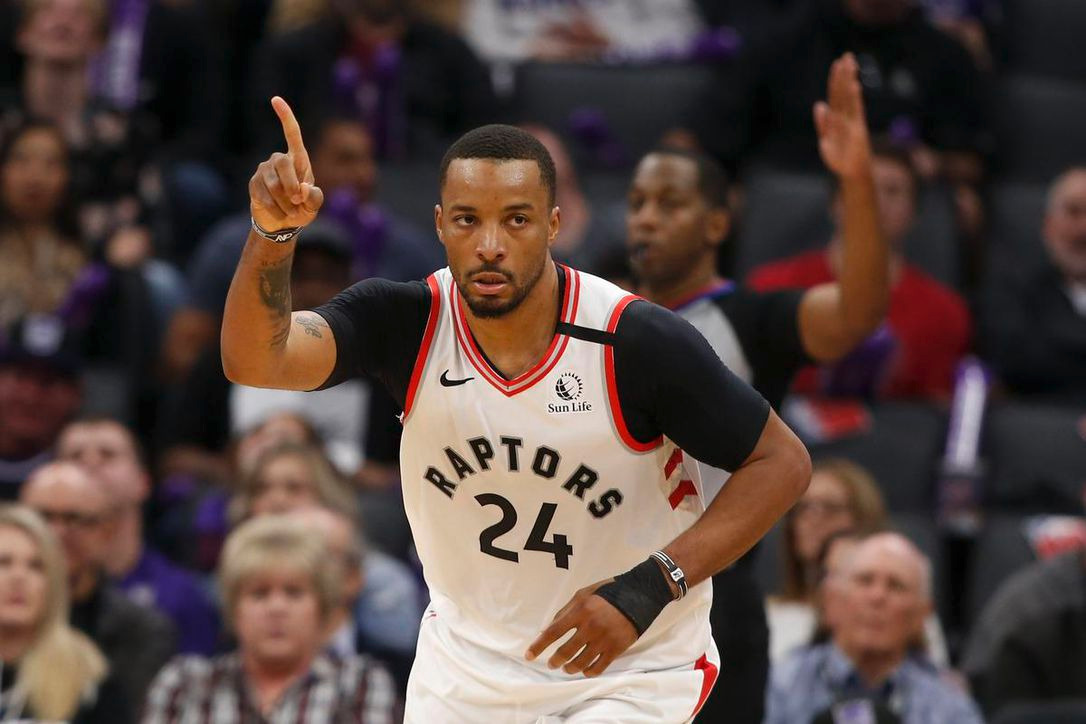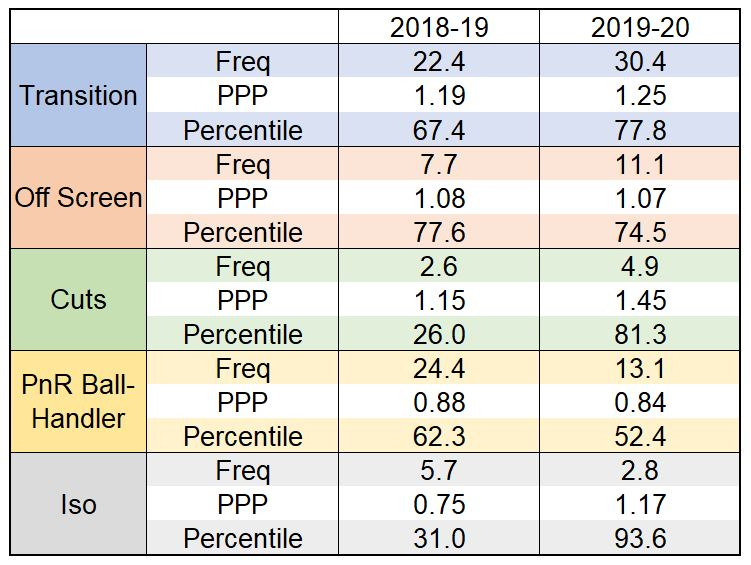What Went Right: Norman Powell

Norman Powell has shown flashes of brilliance throughout his career. As a rookie, he burst onto the scene with some impressive playoff performances against the Pacers in Toronto’s first-round victory, emerging as the team’s apparent best hope at slowing down Paul George. His second season was a bit of a plateau before a dreadful third season put his long-term prospects in doubt.
Dwane Casey seemed to trust Powell less and less, with the UCLA product slipping to 15.2 mpg. He started the first 12 games of the season and then missed four with a hip injury, during which time OG Anunoby took the starting gig and never looked back. Powell looked to have his confidence shaken, and he shot just .401 from the field and an ugly .285 from the 3-point line.
Last season was a much-needed rebound campaign as he took on more of a prominent role in a deeper Raptors rotation that featured less depth at shooting guard. A 21-game absence due to a shoulder subluxation took some of the wind from Norm’s sails, but he trended up in all the right ways: 18.8 mpg, a .483 mark from the field and a clean 40 percent from deep. Though he didn’t wow anyone in finishing as the 224th/232nd ranked player (per game) in 8/9-cat formats, Powell showed that he had the tools to become a potentially useful fantasy option if his role could continue to grow.
When COVID-19 shut down the NBA, Powell and fantasy GMs were enjoying the finest season of his five-year career. Norm was posting career-highs in each of the eight standard fantasy categories with 16.4 points, 3.7 rebounds, 1.8 assists, 1.3 steals, 0.4 blocks and 2.1 3-pointers per contest to go with a sterling .502 mark from the field and an .838 conversion rate from the line. That all added up to the 62nd/53rd ranked fantasy player on the year.
In looking at the stats, the real eye-poppers are the increases in points (up from 8.6) and steals (up from 0.7). The rest of Norm’s numbers rose, yes, but not nearly at the rate of those critical figures considering his playing time jumped from 18.8 to 28.8 mpg. Some of that is a simple matter of volume, as Powell also nearly doubled his previous career-high in field goal attempts, jumping from 6.7 to 11.7 per contest, but the level of improvement in Powell’s tentpole stats, plus the massive gains in efficiency, points to something more significant under the hood.
One of the first things that sticks out about Powell’s shot profile this season is a spike in the percentage of his buckets that come off assists. This year, 77.6% of his makes have come as a result of assists from his teammates, as opposed to just 68.4% during the championship season. That speaks to the changes Toronto’s offense has undergone as a whole without Kawhi Leonard.
With Kawhi, the Raptors were obviously a tremendous team but often needed to flip the switch between two modes of offense. When Leonard was at his best the rest of the roster was in pure support mode, giving him the ball in his spots and clearing out. When Leonard wasn’t on the floor, the Raptors ran a system that was reliant on ball-movement and cohesion to generate open shots. Last season, Leonard and Pascal Siakam ran isolation plays on 16.5% and 9.9% of their possessions, respectively. Although Siakam has skyrocketed to 18.6% in his first year as the main option, the second-most frequent isolator is Fred VanVleet at 7.7% — and that’s down from 7.8% last season, when he ranked third on the team in iso frequency. This version of the Raptors is more liable to have the ball humming, and it’s getting everyone better shots.
Powell has been one of the main beneficiaries, as you might’ve guessed from his drastic upswing in field goal percentage. Through 1,269 minutes this year (we’ll use minutes instead of games to help account for the boost in playing time), Powell has been credited with 207 combined layups and dunks – last season he had 155 in 1,126 minutes. That’s nearly a 33% increase in the easiest shots in the sport with an increase of just 13% in minutes.
Surprisingly, Powell is only taking 5.3 drives per game, barely up from last season’s 5.1 mark, which means those shots at the rim are being generated in other ways.
The difference stems from how he’s being deployed. Take a look at the
shift in Powell’s participation by play type, with both the resulting
points per possession (PPP) and the percentile rank of Norm’s PPP
figures:

The one thing that doesn’t track in that table is Powell’s numbers off cuts, which we’ll get to in a second.
It’s clear that the Raptors have found Powell positions to succeed;
they’ve dialed up the rate of things he already did well, even if he’s
lost a little efficiency, and pulled back on play types that
historically didn’t put his best foot forward. (That Powell has become a
better iso player on lower volume seems like a bit of a happy
accident.) In the video below, keep loose track of how many plays result
from Powell’s athleticism shining in transition, or from exploding to
the rim as a result of screens or cuts.
More than that, note how decisive Powell is. It seems likely that his ability to go right into attack mode has led to his vast improvements as a cutter, as the clip above features Powell just blowing past a number of defenders who are off guard when he rockets to the rim.
That attacking mentality is manifested in stats relating to the touches he receives in-game. Powell averages just 2.45 seconds per touch and takes 1.83 dribbles, both way down from last year’s 2.86 and 2.35 marks. When he gets close to the rim, it’s over; among players with 24 or more minutes per game, Powell ranks eighth in the league with 1.114 points per paint touch. That puts him just ahead of Derrick Jones Jr., Anthony Davis, Zion Williamson and John Collins. Not only is Powell fulfilling different roles in the offense; he’s doing pretty much everything both faster and more efficiently.
We’d be remiss not to point out that Powell has seen extra playing time as a result of Toronto’s rash of injuries –Terence Davis and OG Anunoby are the only rotation regulars to miss fewer than 11 games – but the numbers point to a newer, optimized version of Powell’s game.
Powell’s improvements culminated in an outstanding stretch right after he returned from another shoulder subluxation. From January 12 to 26, Powell averaged 19.9 points, 1.3 steals and 2.9 triples per game while shooting a blistering .548 from the field. He opened that stretch with five straight games of 20 or more points, slotting into the top-35 in fantasy in that time.
Somehow Powell was even better right before the league shuttered, returning top-15 value over an absurd five-game span in which he averaged 28.0 points, 1.4 steals, 0.6 blocks and 3.4 3-pointers on .527 shooting. That run closed with back-to-back 30-bombs, including a career-best 37 points against the Warriors, and began as soon as Norm returned from a nine-game absence caused by a finger fracture.
While some of Powell’s improvement can be chalked up as variance and additional opportunity that can’t be projected, the Raptors have made tangible changes to how the offense runs. Powell isn’t occupying an entirely new role – he’s still the go-to bench scorer, as he was last year – but is instead maximizing his production within it thanks to a series of tweaks that have added up to something vital as the team prepares for another playoff run.
The Raptors have pushed the right buttons to turn Powell into a legitimate offensive threat without needing heavy shot volume. Things would likely look different if Toronto had a cleaner bill of health this season, but fantasy players should feel confident that the team is so clear-minded about their evaluation of Powell. They know how to get him going, and Powell has held up his end of the bargain in a fantasy campaign where so much has gone right.
Post a comment